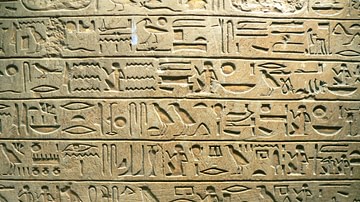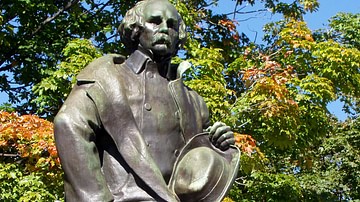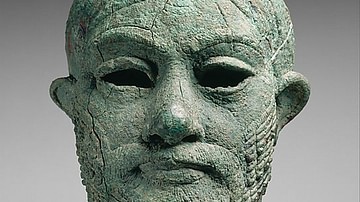
Nathaniel Hawthorne (1804-1864) was an American author of novels and short stories, who produced some of the most memorable works of American literature: the novels The Scarlet Letter and The House of the Seven Gables as well as the short stories Young Goodman Brown and My Kinsman, Major Molineaux, among many others.
Early Life
Nathaniel Hawthorne was born on 4 July 1804 in Salem, Massachusetts, the second of three children; he had two sisters Elizabeth and Louisa. His early life was spent reading, most often alone. When Hawthorne was four years old in 1808, his father died of yellow fever, causing his mother to become reclusive. His home's old, dusty library, with its stacks of histories and novels, was Hawthorne's salvation. This home of his youth later became the setting for The House of the Seven Gables. At the age of nine, he injured his foot. Housebound and bedridden, he spent the next two years recovering and reading. Robert Mead in his Literature of the American Nation wrote that Hawthorne, alone, sat in the old library reading, absorbing the history of his family and "the somber calamities of the seventeenth-century founders with their Indian wars and terror of witchcraft" (126).
Through family connections, in 1821, he entered Bowdoin College, graduating in 1825. At Bowdoin, he became acquainted with the poet Henry Wadsworth Longfellow (1807-1882) and the future president Franklin Pierce (1804-1869). After graduating from Bowdoin College, Hawthorne returned to Salem with the goal of becoming a writer, leaving his home only for his daily long walks. He "disappeared like a stone dropped into a well" (Cowley, 1). However, the years after leaving Bowdoin can be considered a "literary apprenticeship," a time of reading and writing (Timko, 61). In 1828, he published his first novel Fanshawe: A Tale at his own expense. Later, he began to submit small pieces to the Salem Gazette.
Career
In 1836, he was in Boston editing the monthly American Magazine of Useful Entertaining Knowledge, which ceased publication in 1837. With the help of his old college acquaintance Franklin Pierce, in 1839, Hawthrone obtained an appointment as a weigher and gauger at the Boston Custom House. Between 1841 and 1842, he spent several months at Brook Farm, a utopian transcendentalist community, where he met the journalist and women's rights advocate Margaret Fuller (1810-1850). Her influence can be seen in Hawthorne's female characters with strong passion. The best example of this is Hester Prynne in The Scarlet Letter, a novel that dealt with the "moral decadence of seventeenth-century New England Puritanism" (Morris, 725). Brook Farm also became the setting for The Blithedale Romance (1852), a novel on the life and death of a utopian community.
On 9 July 1842, he married Sophia Amelia Peabody of Salem and settled in Concord at Old Manse. They would have three children: Una, Julia, and Rose. Even after he married, Sophia respected Nathaniel's desire for solitude and encouraged his writing. Time to be alone was an emotional necessity for him, which "deepened and individualized his talent" (Cowley, 4). Over their time together, they moved several times, living for a short time in Lenox in the Berkshires where they became friends with the novelist Herman Melville (1819-1891).
In 1846, Hawthorne received a second appointment as a surveyor at the Boston Custom House, only to be discharged on 8 June 1849 with the election of the Whig Zachary Taylor as president. That night, with the encouragement of Sophia, Hawthorne began to write The Scarlet Letter. In 1850, it was published. A year later he published his second novel, The House of the Seven Gables. In 1852 he returned to Concord, buying "The Wayside." That same year he wrote The Life of Franklin Pierce, a campaign biography of the presidential hopeful. After Pierce's election in 1852, Hawthorne and his family moved to Liverpool where he became the American consul, resigning in 1857 due to politics They remained in London for two months. During his time in London, he did little writing, only maintaining his notebooks.
In 1858, he and his family traveled through France and Italy. While in Florence, he began to write The Marble Faun, published in 1860. In Rome, Una became ill with a lingering fever. With his own health failing, he moved back to London, eventually returning to Concord and "The Wayside" in 1860. While traveling to visit Pierce in New Hampshire, Hawthorne died in his sleep on 19 May 1864 in Plymouth, New Hampshire. After his death, Sophia edited his notebooks and published them posthumously.
Influences
During the 1840s, New England was the setting for a new movement, transcendentalism, and Concord, Massachusetts, was the home of a number of New England's greatest authors such as Ralph Waldo Emerson (1803-1882), Henry David Thoreau (1817-1862), and Louisa May Alcott (1832-1888). Although it was not considered a philosophy, transcendentalist ideas of self-reliance, self-determination, and the divinity of human nature are evident in the works of Emerson and Thoreau, whom Hawthorne came to know and admire.
One of the great influences on Hawthorne's life was his friendship with Ralph Waldo Emerson. Despite their friendship, Hawthorne was not a transcendentalist, but after his years of solitude in Salem, Hawthorne felt reborn in a "transcendental" Concord and "absorbed something of a spirit of renewal" (Hawthorne, xiii). Samuel Morison wrote that transcendentalism gave Hawthorne "his perception of beauty and tragedy of life" (522). Even though he embraced some of its beliefs, the focus of his writings was not as intense as Emerson's. Instead, Hawthorne's novels and short stories are filled with a sense of New England's Puritan past. Writing in the 19th century, Hawthorne looked 200 years into the past, trying to understand his Puritan ancestors and the "dark legacy they passed down to the generations that followed" (Scarlet, viii). He presented a "somber portrayal of a Puritan mind of New England, searching out the play of evil and the ramifications of sin, guilt, and remorse" (Morris, 611).
On his long walks with Emerson, Hawthorne listened to Emerson's optimism toward humanity and the virtue of self-reliance, but this was contrary to the self-obsession of Puritanism. Hawthorne's novels and short stories often presented a proud individual who had "cut himself away from society and suffered the tortures of isolation" (Cowley, 12). Hawthorne had learned from his years of seclusion that living by and for oneself was a sin against nature. He was an individualist but not like Emerson. Hawthorne did not speak of self-reliance but believed that every individual is dependent on society. While in Concord, Hawthorne and his family lived in a home built by Emerson's grandfather – Emerson even lived there on occasion.
While never associating himself with any organized religion, Hawthorne was still a man of faith. Out of his inner struggles and a sense of guilt, he developed a personal theology, deeply Christian and orthodox. Like his Puritan ancestors, he believed in predestination, yet saw order in the confessions and absolution of Catholicism. He believed in original sin and providence, as well as a future life where the guilty will be punished by the self-knowledge of their sins. In the plots of his stories, he emphasized sin and retribution more than reformation through divine grace. He did not accept that all sinners are hopelessly damned as the tenets of Puritanism claimed. He did, however, believe in one unpardonable sin: intellectual pride.
Works
Hawthorne's most famous short stories include:
- Roger Malvin's Burial (1832)
- My Kinsman, Major Molineaux (1832)
- Young Goodman Brown (1835)
- The Gray Champion (1835)
- Wakefield (1835)
- The Minister's Black Veil (1836)
- Dr. Heidegger's Experiment (1837)
- The Birth-Mark (1843)
Many other short stories, including children's stories, were published in collections such as:
- Twice-Told Tales (1837)
- Grandfather's Chair (1840)
- Mosses from an Old Manse (1846)
- Wonder-Book for Girls and Boys (1851)
- The Snow-Image, and Other Twice-Told Tales (1852)
- Tanglewood Tales for Boys and Girls (1853)
Hawthorne also wrote several novels:
- Fanshawe: A Tale (1828)
- The Scarlet Letter (1850)
- The House of the Seven Gables (1851)
- The Blithedale Romance (1852)
- The Marble Faun (1860)
The Scarlet Letter
Hawthorne's most famous novel, The Scarlet Letter is about a love affair between Hester Prynne and Reverend Dimmesdale, resulting in a disgraced single mother and a pious fraud.
The preface to The Scarlet Letter, which gives an explanation of the story is considered autobiographical in some ways. The narrator in the story is a surveyor in disfavor with the political system, as was Hawthorne. At the Essex Historical Society, the narrator (Hawthorne) comes across a faded and worn scarlet cloth. He examines it and the small roll of paper beside it. The old paper provides an explanation for the cloth and its capital letter "A". "My eyes fastened themselves upon the old scarlet letter and would not be turned away" (Hawthorne, 31). After further examination, he determines the cloth was an article of dress. From his reading, he learns of Hester Prynne, "a rather noteworthy personage in the view of our ancestors." Hawthorne keeps the cloth. "It was the subject of my meditation for many an hour" (Hawthorne, 33). And in it, he sees the subject of a tale.
Although Hester and her child, Pearl, are isolated by Puritan society, Hester is not humbled by the punishment: wearing a scarlet "A" upon her chest. Despite being ostracized, she refuses to disclose the identity of the child's father, and the letter becomes a "a symbol of social defiance" (Hawthorne, xviii). She is a hero, "a strong woman at peace with herself" (ibid). She finally confronts the Reverend and tells him that he must answer only to himself and accept his guilt. In the end, he finally confesses before everyone, admitting to being a hypocrite consumed by his shame. Having suffered from a long illness, he dies in Hester's arms. Despite being banned in some states, The Scarlet Letter has been called one of Hawthorne's greatest works. It is still being read almost 175 years after its publication, and people still discuss the courage and pride of Hester and the cowardice of the Reverend.










